Physical Address
304 North Cardinal St.
Dorchester Center, MA 02124
Incorporation of routine intraoperative assessment of axillary sentinel lymph node and breast tissue is feasible at most breast surgery centers and may result in significant clinical benefit to the patient. The use of intraoperative frozen section is reported to reduce the number of operations and therefore the cost of treating patients with breast cancer (Sabel et al, 2012). Sabel et al reported that intraoperative frozen section decreased the average number of operations from 1.5 to 1.23 per patient, and the percentage of patients undergoing a single surgical procedure increased from 59% to 80%. Subsequently, surgery for reexcisions decreased from 26% to 9%. Frozen section allowed 93% of node-positive patients to avoid a second operation for axillary lymph node dissection (Sabel et al, 2012).
Based on our experience and the experiences of other groups, routine frozen section for breast surgery should be considered for:
Sentinel lymph node biopsy during mastectomy and rarely lumpectomy
Assessment of tissue from nipple when nipple-sparing mastectomy is being performed
Diagnosis of invasive carcinoma when no prior breast core biopsy was performed, although it’s discouraged in some institutions
Evaluation of resection margins in highly selected situations
We will discuss in each topic: indications for frozen section, technical quality assurance, interpretation of frozen section results, and diagnostic pitfalls.
When identifying metastatic carcinoma in sentinel lymph node (SLN) will lead to further axillary lymph node dissection
In some institutions, patients with clinically early breast cancer undergo axillary ultrasound. Abnormal nodes are defined as a cortex greater than 2.5 mm and loss of high echogenic medulla. Any patient with an abnormal lymph node undergoes ultrasound-directed fine-needle aspiration (FNA). Patients with positive cytology proceed directly to axillary dissection. Patients with negative cytology and those with normal ultrasound proceed to sentinel lymph node biopsy using patent blue dye. The sentinel node is then evaluated intraoperatively. If no metastatic carcinoma is identified, the surgeon will not sample additional axillary lymph nodes. In contrast, positive sentinel lymph node for metastatic carcinoma will lead to further axillary lymph node dissection. This will ensure appropriate axillary surgery in a single operation for breast cancer patients (Sanders et al, 2011; Moriya et al, 2004; Klepchick et al, 2004).
The goal of sentinel lymph node frozen section is to identify metastasis greater than 0.2 mm. Accurate diagnosis of microscopic focus of metastatic carcinoma requires proper handling of the specimen.
The lymph node needs to be serially sectioned into 2-mm thick slices. The consistency, color, dye, and obvious tumor should be documented. The lymph node should be entirely frozen. If multiple lymph nodes are submitted in the same chuck, each lymph node should be differentially inked ( Figure 15-1 ). Sections that are 5 μm thick are prepared on a -20° C cryostat and placed on plus slides (a blank slide with a positive charge that allows frozen tissue to stick better); at least two levels of each lymph node are examined.
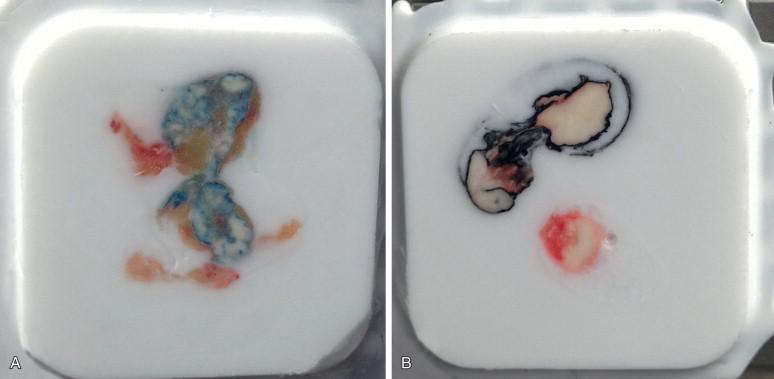
All tissue sections should be identified entirely on frozen section slide. Additional deeper sections must be obtained if necessary. Screening the lymph node at low- and then high-power fields will identify any possible metastatic carcinoma ( Figure 15-2 ).
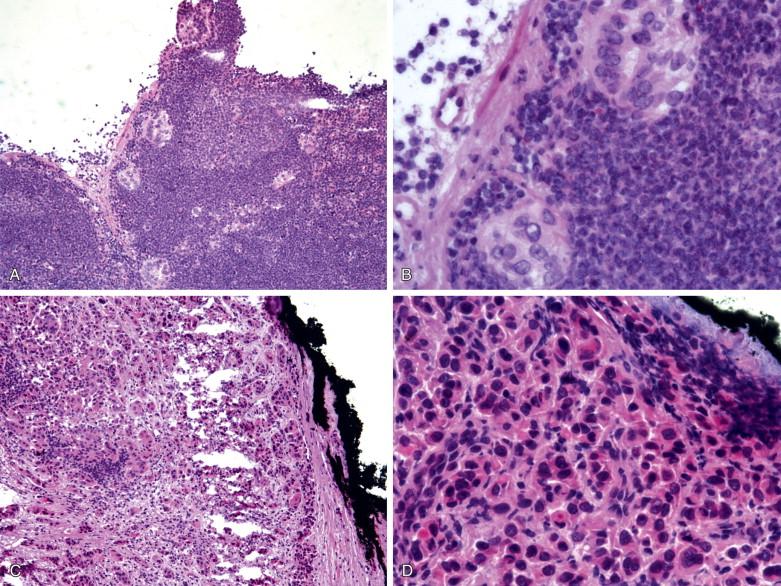
Sinus histocytosis: Metastatic carcinoma is frequently seen in the subcapsular sinus of the lymph node. Clusters of histiocytes in the sinus near the capsule may mimic metastatic carcinoma particularly at lower power. Differentiation between histiocytes and metastasis becomes more difficult when the quality of the frozen section is suboptimal or the histiocytes exhibit prominent nucleoli, simulating a metastatic ductal ( Figure 15-3 ) or lobular carcinoma ( Figure 15-4A, B ). Touch prep sometimes is very helpful in distinguishing metastatic carcinoma ( Figure 15-4C, D ) from histiocytes.
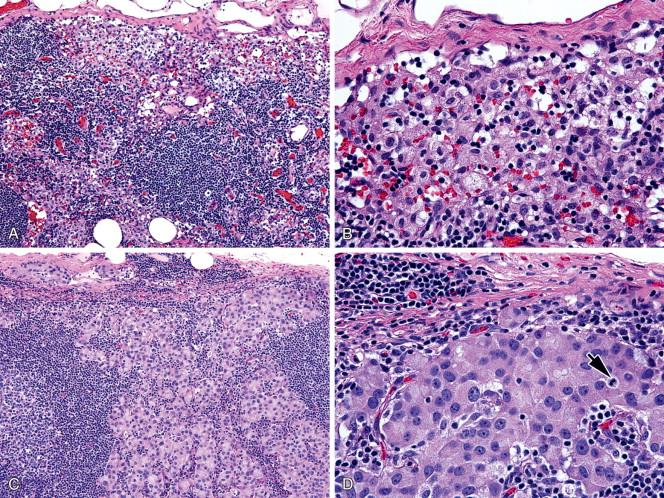

Heterotopic glands: Heterotopic benign glandular tissue has been found in axillary lymph nodes. Heterotopic glandular inclusions in the axillary lymph nodes are derived from the breast or skin adnexa (Layfield and Mooney, 2000; Holdsworth et al, 1988). They usually appear as benign glandular elements composed of two cell layers. However, they may undergo squamous metaplasia, develop epithelial hyperplasia, or become cystic ( Figure 15-5A, B ). Ciliated metaplasia of the lining epithelium can also be seen ( Figure 15-5C, D ). On the other hand, true metastatic carcinoma ( Figures 15-6 and 15-2A, B ) may also be mistaken for heterotopic glands in axillary lymph node. The presence of cytologic atypia, architecture irregularity, and desmoplasia may help in distinguishing true metastatic carcinoma from the heterotopic glands.
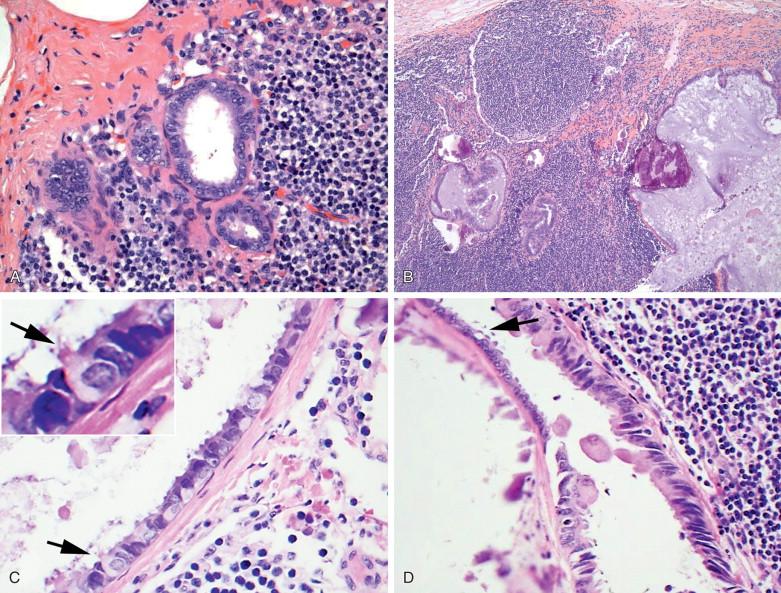
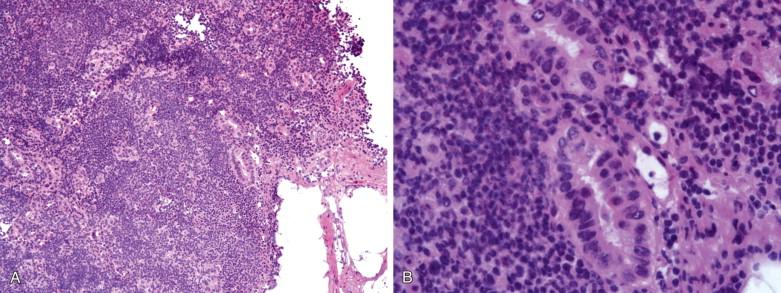
Nevus cell aggregates (NCA): Collections of cells that resemble cutaneous nevi can be found in the capsules of axillary lymph nodes. The origin of this anatomic variation is unknown, but origin in the lymph node capsule has been suggested. Histologically, the NCA may appear as angioglomic structures derived from perithelial cells with glomus properties around vessels in the lymph node capsule ( Figure 15-7 ) (Lambert and Brodkin, 1984; Micheau et al, 1971). NCA may have some melanin pigments. Some patients have a notable contiguous cutaneous nevus or blue nevus. The nevus cells are characterized by bland uniform cytology which may help to distinguish them from metastatic carcinoma ( Figure 15-6 ).
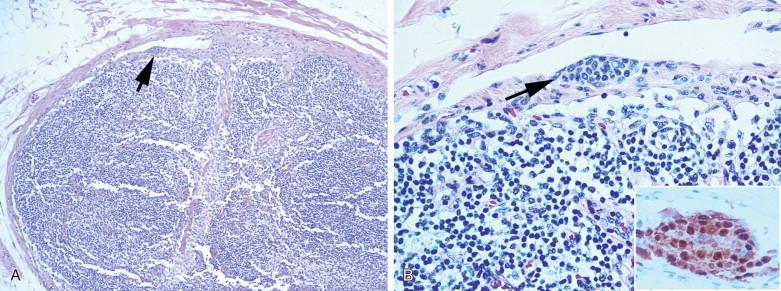
Become a Clinical Tree membership for Full access and enjoy Unlimited articles
If you are a member. Log in here